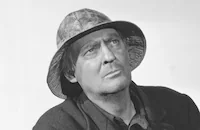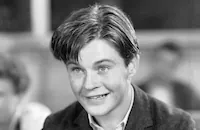This Side of Heaven

Brief Synopsis
Cast & Crew
William K. Howard
Lionel Barrymore
Fay Bainter
Mae Clarke
Tom Brown
Una Merkel
Film Details
Technical Specs

Synopsis
While Francene Turner, a housewife-turned-writer, spends her day in the city selling her first novel to a movie studio, her son Seth introduces himself to the college fraternity he hopes to join, and her youngest daughter Peggy goes to see a movie with her boyfriend, Hal Jennings. At the same time, schoolteacher Jane Turner, Francene's eldest daughter, explains to longtime admirer Vance Patterson, a freelance writer and newspaper reporter, that she is marrying Walter Hamilton because, unlike Vance, he is safe and reliable. While Jane then confers with Walter, an auditor, about their wedding plans, her father Martin, the chief accountant at a local firm, is called in by William Barnes, the company president, to explain a $40,000 deficit in the company books. After assuring Barnes that the money will be accounted for, Martin confronts general manager R. S. Sawyer, about the missing funds, which Sawyer had appropriated with Martin's help on the pretext of using them as a loan to a struggling client. Sawyer confesses to Martin that the money actually was used for his own financial speculations, but promises to try to secure $40,000 before the next day's audit. Overcome with worry, Martin returns home and, while waiting for Sawyer's telephone call, promises Seth fifty dollars to pay his fraternity initiation fees, blesses Jane and Walter's engagement, and congratulates Francene on her movie deal. The next morning, after Sawyer has informed him that he was unable to get the money, Martin says goodbye to Peggy, who is taking the train for college that afternoon, and prepares all of his personal financial papers. At lunch, Francene confides in Martin that the Hollywood studio has offered her a six-week stint as a contract writer, and Martin encourages her to accept the job. Then, while Peggy abandons the train to drive to college with Hal, Walter, who is preparing Martin's audit, confronts him about the apparent embezzlement. Although Martin, who has since learned that Sawyer has left town, maintains his innocence, Walter suggests that he, too, leave town to avoid involving his family in scandal. Seemingly trapped, Martin returns home and, in his study, swallows an overdose of a powerful sinus medicine. At the same time, Peggy, who on a whim has gone with Hal to a country minister, finds a telling note from her father in her suitcase and rushes home without being married. Seth, meanwhile, learns that the fraternity rejected him and, while driving home, is blinded by his tears and crashes into a streetcar. The heavily drugged Martin is taken by the police to Seth's hospital room, where the unsuspecting Seth confesses to him that, for a moment, he had wanted to die. Moved by Seth's words, Martin struggles to stay awake but soon slips into unconsciousness. Eventually Francene and the rest of the family are informed of Martin's predicament and rescue him from death. Then, armed with information from Vance, Barnes arranges for Sawyer's apprehension at the Mexican border and fully vindicates Martin. After Jane breaks with Walter and embraces Vance, Seth announces that he has been nominated as class vice-president, and Martin sits down to dinner with his entire loving family.

Director

William K. Howard
Cast

Lionel Barrymore

Fay Bainter

Mae Clarke

Tom Brown

Una Merkel

Mary Carlisle

Onslow Stevens

Henry Wadsworth

Eddie Nugent

C. Henry Gordon

Dickie Moore
Edwin Maxwell
Richard Tucker
Claire Du Brey
Sumner Getchell

Nell O'day
Herbert Prior
Edward Le Saint
Phil Tead

Lee Phelps
Paddy O'flynn
Geneva Mitchell
Aileen Carlyle
Nell Craig
Paul Stanton
Theodor Von Eltz
Bobby Watson

Dawn O'day
Charles Williams
James Durkin
Charles Giblyn
Mickey Daniels

Ed Norris
Billy Taft
Stanley Taylor
Niles Welch
Crew
Dr. William Axt
John W. Considine Jr.
Eve Greene
Fredric Hope
Horace Hough
William K. Howard
Frank Hull
Hal Rosson
Florence Ryerson
Zelda Sears
Douglas Shearer
Edwin B. Willis
Edgar Allan Woolf

Film Details
Technical Specs

Articles
This Side of Heaven
This was Barrymore's 156th credited movie (at least) in a career stretching back to 1911. (A possible 1908 credit is unconfirmed.) He was, quite simply, an old pro and a living embodiment of most of the history of American film production -- and his career would continue in full swing for more than fifteen further years. Barrymore got good marks for This Side of Heaven, with Variety gushing, "The most gifted member of the Barrymore family adds another distinctive character to his gallery. He works with quiet authority and never in pictures did a man take poison with greater effect or fewer gestures."
According to press reports of the time, when This Side of Heaven began its run at New York's Capitol Theatre, Barrymore himself could be seen in the Capitol stage show prior to each night's screening, performing his role from the last act of The Copperhead -- a play he had performed on Broadway back in 1918. Buddy Rogers also appeared in this live show, "giving a program of music, song and comedy."
On the other end of the spectrum, this was Fay Bainter's film debut, noted by the trade paper Variety as "a wise choice... [she] gives an intelligent portrayal and shows she has much for the screen." At age 40, Bainter was already an established Broadway star, and following this picture she would return to the stage to take on the role of the wife in Dodsworth, opposite Walter Huston. Huston would soon reprise the part of Dodsworth for the film version, while Bainter's part went to Ruth Chatterton. In fact, it would be three years until Bainter appeared in her second film, Quality Street (1937), but from then on she stayed almost exclusively in Hollywood. She'd eventually be nominated for three Oscars®, for White Banners (1938), Jezebel (1938) and The Children's Hour (1961), winning for Jezebel.
The director of This Side of Heaven, William K. Howard, is completely forgotten today, but when he made this film he'd been directing for thirteen years and was a serious creative force in Hollywood. In the May 1954 issue of Films in Review, respected film historian William K. Everson wrote a comprehensive piece looking back on Howard, calling him the "creator of some of the best melodramas ever made" who in 1934 was at the peak of his talent: "His pictures were solidly constructed, smoothly executed, and visually delightful, thanks to apt camera angles and discriminating use of the moving camera." Hollywood noted this at the time, too, with the trade paper The Hollywood Reporter praising Howard for his ability on This Side of Heaven "to juggle a dozen situations without losing a central theme.... [He] has made it seem spontaneous rather than spotty." Howard's most famous silent film had been White Gold (1927), an odd, psychological western that was a well-reviewed commercial flop and which Everson called one of the best films of the silent era. Later, Howard turned out fine melodramas at Fox like Scotland Yard (1930), Transatlantic (1931), and Sherlock Holmes (1932), and made four pictures with actor Edmund Lowe, all big moneymakers. After directing The Power and the Glory (1933), a famous Spencer Tracy picture written by Preston Sturges that significantly influenced Citizen Kane (1941), Howard signed with MGM and delivered five glossy melodramas, the first of which was This Side of Heaven. Later he directed two films at Paramount, including the underrated Mary Burns, Fugitive (1935), worked in England for a time, and returned to freelance around Hollywood, mostly turning out B movies.
The film-within-the-film shown here, in a scene in which two characters go to the movies, is from MGM's 1933 Another Language, though according to the AFI catalogue notes, the footage shown was not included in that film's final release print.
Producers: John W. Considine, Jr., William K. Howard
Director: William K. Howard
Screenplay: Edgar Allan Woolf, Florence Ryerson (screenplay); Zelda Sears, Eve Greene (adaptation); Marjorie Bartholomew Paradis (novel)
Cinematography: Harold Rosson
Art Direction: Fredric Hope
Music: Dr. William Axt
Film Editing: Frank Hull
Cast: Lionel Barrymore (Martin Turner), Fay Bainter (Francene Turner), Mae Clarke (Jane Turner), Tom Brown (Seth Turner), Una Merkel (Birdie), Mary Carlisle (Peggy Turner), Onslow Stevens (Walter Hamilton), Henry Wadsworth (Hal Jennings), Edward J. Nugent (Vance Patterson, as Eddie Nugent), C. Henry Gordon (William Barnes).
BW-77m.
by Jeremy Arnold

This Side of Heaven
Quotes
Trivia
Notes
The working titles of this film were It Happened One Day, A Big Day and The Family Scandal. In one scene, footage from the 1933 M-G-M family drama Another Language, featuring Helen Hayes, Robert Montgomery, Minor Watson and Margaret Hamilton, is seen as a "movie-within-the-movie." A comparison between the copyright cutting continuity of Another Language and the dialogue as recorded in the copyright cutting continuity of this film suggests that the footage was not actually used in the 1933 release print. According to a September 1933 Film Daily news item, Alice Brady and Frank Morgan were first assigned to star in This Side of Heaven. John Barrymore was also announced in a Film Daily news item as a star, but this announcement May have been erroneous. Fay Bainter made her screen debut in the film.















